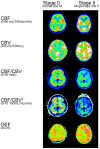A Novel Proposal for an Index for Regional Cerebral Perfusion Pressure - A Theoretical Approach Using Fluid Dynamics
- PMID: 35173665
- PMCID: PMC8841875
- DOI: 10.3389/fneur.2021.765463
A Novel Proposal for an Index for Regional Cerebral Perfusion Pressure - A Theoretical Approach Using Fluid Dynamics
Abstract
Cerebral blood flow (CBF) / cerebral blood volume (CBV) ratio derived by [15O] H2O/ CO2 and CO positron emission tomography (PET) examination has been used as an index for cerebral perfusion pressure (CPP). CBF/CBV was demonstrated to be related mean arterial pressure (MAP) in baboons. However, this formula has not been confirmed to be proportionate to CPP. We have developed a new index for CPP using the Poiseuille equation based on a simple model. Our model suggests that CBF/CBV2 is proportionate to CPP and that it is mathematically a more accurate index than CBF/CBV. This new index needs experimental validation in the future.
Keywords: cerebral blood flow (CBF); cerebral blood volume (CBV); cerebral perfusion pressure (CPP); fluid mechanics; positron emission tomography (PET).
Copyright © 2022 Kameyama, Momose, Ishibashi and Ishii.
Conflict of interest statement
The authors declare that the research was conducted in the absence of any commercial or financial relationships that could be construed as a potential conflict of interest.
Figures




Similar articles
-
Evaluation of the ratio of cerebral blood flow to cerebral blood volume as an index of local cerebral perfusion pressure.Brain. 1998 Jul;121 ( Pt 7):1369-79. doi: 10.1093/brain/121.7.1369. Brain. 1998. PMID: 9679787
-
CBF/CBV maps in normal volunteers studied with (15)O PET: a possible index of cerebral perfusion pressure.Neurosci Bull. 2014 Oct;30(5):857-62. doi: 10.1007/s12264-013-1458-0. Epub 2014 Aug 1. Neurosci Bull. 2014. PMID: 25085575 Free PMC article.
-
Paradoxical reduction of cerebral blood flow after acetazolamide loading: a hemodynamic and metabolic study with (15)O PET.Neurosci Bull. 2014 Oct;30(5):845-56. doi: 10.1007/s12264-013-1459-z. Epub 2014 Aug 6. Neurosci Bull. 2014. PMID: 25096497 Free PMC article.
-
Human cerebral circulation: positron emission tomography studies.Ann Nucl Med. 2005 Apr;19(2):65-74. doi: 10.1007/BF03027383. Ann Nucl Med. 2005. PMID: 15909484 Review.
-
Nonsurgical management of increased intracranial pressure.Semin Neurol. 1989 Sep;9(3):218-24. doi: 10.1055/s-2008-1041328. Semin Neurol. 1989. PMID: 2700510 Review.
Cited by
-
Correlating stroke risk with non-invasive cerebrovascular perfusion dynamics using a portable speckle contrast optical spectroscopy laser device.Biomed Opt Express. 2024 Sep 30;15(10):6083-6097. doi: 10.1364/BOE.534796. eCollection 2024 Oct 1. Biomed Opt Express. 2024. PMID: 39421763 Free PMC article.
-
Prognostic value of CBV index in patients with acute ischemic stroke treated with endovascular thrombectomy in late therapeutic window.Front Neurol. 2024 Jan 8;14:1282159. doi: 10.3389/fneur.2023.1282159. eCollection 2023. Front Neurol. 2024. PMID: 38259642 Free PMC article.
-
Characterization of cerebral blood flow during open cardiac massage in swine: Effect of volume status.Front Physiol. 2022 Oct 4;13:988833. doi: 10.3389/fphys.2022.988833. eCollection 2022. Front Physiol. 2022. PMID: 36267585 Free PMC article.
References
-
- Okazawa H, Yamauchi H, Toyoda H, Sugimoto K, Fujibayashi Y, Yonekura Y. Relationship between vasodilatation and cerebral blood flow increase in impaired hemodynamics: a PET study with the acetazolamide test in cerebrovascular disease. J Nucl Med. (2003) 44:1875–83. - PubMed
LinkOut - more resources
Full Text Sources

